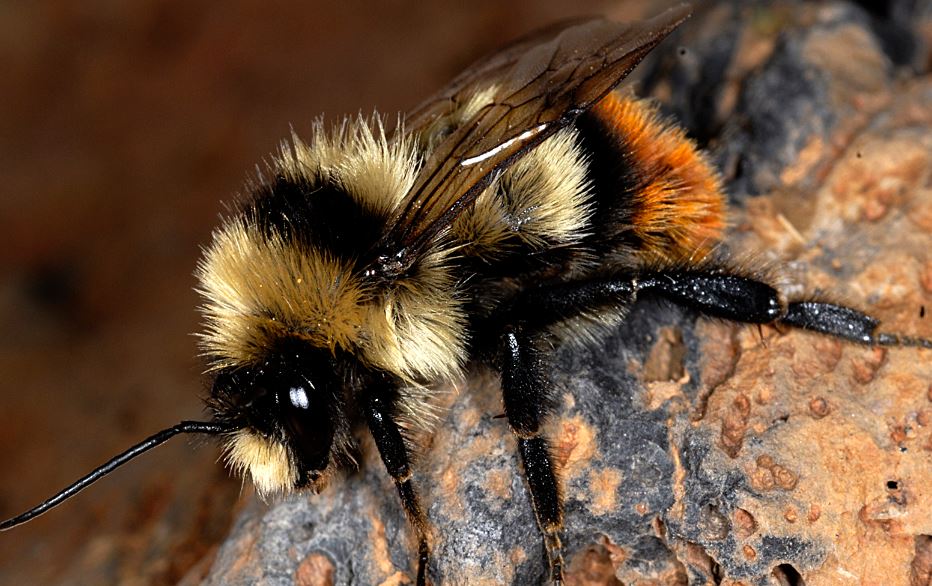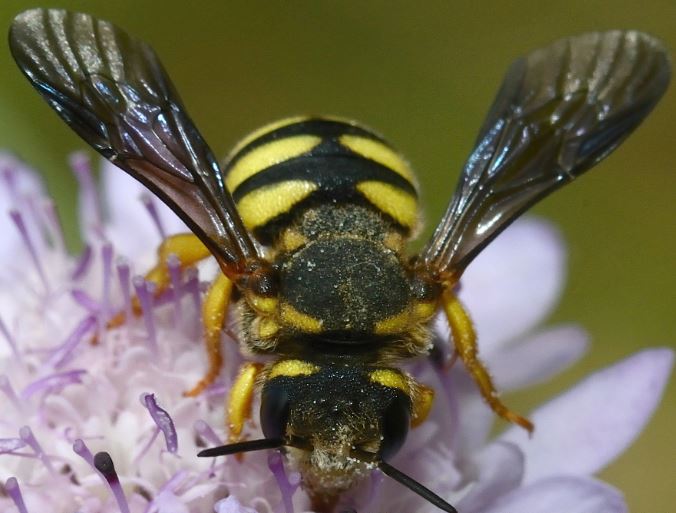Nearly one tenth (9.2%) of all European wild bee species are threatened with extinction, according to an assessment published on Thursday as part of the The IUCN European Red List of Bees and the Status and Trends of European Pollinators (STEP) project.
The researchers say that 5.2% of European wild bee species face a serious extinction threat in the near future, while the fate of 56.7% remains unknown due to insufficient data.
Both studies, funded by the European Commission, provide the most comprehensive report to date on the continent’s 1,965 bee species, including their distribution, status, population trends and threats. However, in order to have a full understanding of bee status and outlook, further larger-scale monitoring is needed.

The Bombus cullamanus is classed as ‘critically endangered’. (Image Credit: Pierre Rasmont)
Jean-Christophe Vié, Deputy Director, IUCN Global Species Programme, said:
“This assessment is the best understanding we have had so far on wild bees in Europe. However, our knowledge about them is incomplete as we are faced with an alarming lack of expertise and resources. Bees play an essential role in the pollination of our crops.”
“We must urgently invest in further research in order to provide the best possible recommendations on how to reverse their decline.”
According to the report, 7.7% of species’ populations are declining, 12.6% are stable, while 0.7% are increasing. For the remaining 79% of Europe’s bee species, population trends are unknown.
Farming practices partly to blame
The main threats to the survival of bees have been the increasing intensification of farming plus changing agricultural practices.
For example, intensive silage production – at the expense of hay cropping – results in losses of herb-rich grasslands and season-long flowering, which make up an important source of forage for pollinators, including bees.
While the widespread usage of insecticides harms wild bees, herbicides reduce the number of flowers available, on which they depend.
Because of fertilizer use, grasslands, which are low in flowering plants and legume species, have become the preferred food resources for several species of bees.

Stelis annulata has been proposed to be included in the Red Book as endangered species. (Image Credit: David Genoud)
Modern farming practices and intensive agriculture have reduced the surface area of dry steppes, the vulnerable Andrena transitoria bee’s habitat. This species of eastern Mediterranean bee was common from Sicily to Ukraine and into Central Asia.
Grazing of flowering plants, mowing and ploughing, plus the use of insecticides have driven down the population of Andrena transitoria in Europe by 30% over the last ten years. In some countries the species has become extinct.
Climate change harming bees
Climate change is also believed to be contributing to the demise of most types of bees, especially bumblebees. Abnormally heavy rainfalls, prolonged droughts, heat waves and higher temperatures can alter bees’ habitats to such an extent that they are unable to thrive, and their populations plummet.
According to the assessment, 25.8% of Europe’s bumblebee species are facing extinction.
More frequent fires combined with urban development are threatening the survival of several wild bee species, experts say.
The report also assessed the best-known pollinator – the Western Honeybee (Apis mellifera). Historically, the Western Honeybee has been commonly seen across most of Europe. However, today, experts are not sure how much of its population consists of domesticated (rather than wild) species.
The Western Honeybee assessment has been classed as Data Deficient, given that this study only looked at wild species. Further research is required to distinguish between domesticated and wild colonies to better understand the impacts of pesticides, malnutrition and pathogens (disease-causing organisms such as viruses, bacteria, etc.) on colonies.
Pollination occurs thanks to many bee species
Simon Potts, STEP project Coordinator, said:
“Public and scientific attention tends to focus on Western Honeybee as the key pollinator, but we must not forget that most of our wild flowers and crops are pollinated by a whole range of different bee species.”
“We need far-reaching actions to help boost both wild and domesticated pollinator populations. Achieving this will bring huge benefits to wildlife, the countryside and food production.”
Karmenu Vella, EU Environment, Maritime Affairs and Fisheries Commissioner, said:
“Our quality of life – and our future – depends on the many services that nature provides for free. Pollination is one of these services, so it is very worrying to learn that some of our top pollinators are at risk! If we don’t address the reasons behind this decline in wild bees, and act urgently to stop it, we could pay a very heavy price indeed.”
Policymakers urged to do more
The authors urge policymakers to take the conservation of bees more seriously. More focus is needed on the management of protected areas and European agricultural policies.
Survey programmes at national and pan-European levels, as well as bee taxonomists (biologists who group organisms into categories) should be supported more enthusiastically, in order to make sure the monitoring of the status of bees is done comprehensively and conservation measures are implemented.
We need bees
Our ecosystems as well as agriculture need bees. They provide crop pollinations estimated to be worth €22 billion annually in Europe (€153 billion globally). According to the authors “Pollinators support crops accounting for 35% of global agricultural production volumes.”
Many types of vegetables, fruits and nuts, plus other crops totaling 84% of all agricultural (non-livestock) produce that humans consume require insect pollination to enhance quality and yields.
Examples of insect pollinators in the UK include moths, bumblebees, honeybees, beetles, butterflies, solitary bees, and hoverflies.
The IUCN (International Union for Conservation of Nature) wrote in a statement:
“The European Red List of Bees comes at a time when progress in implementing Europe’s strategy to halt biodiversity loss is under review. The results of this assessment stress the need for the full implementation of EU 2020 Biodiversity Strategy in order to meet the biodiversity target of ‘halting the loss of biodiversity and the degradation of ecosystem services in the EU by 2020, and restoring them in so far as feasible.”
Bumblebees stuck with road-facing hedgerows
Ecologists at Plymouth University last week reported that British bumblebees are increasingly opting more for flowers on road-facing hedgerows, because of the poor pickings on the crop-facing side.
Due to fertilizer and pesticide use in modern farming, the number of flowers on the crop-facing side of hedgerows has declined significantly.
The researchers suggest that farmers should be encouraged to leave a wider barrier between the edge of their crops and hedgerows, which would lessen the effects of chemicals and help wildflowers to flourish.

Widening the margin between crops and hedgerows could help bumblebee populations recover.
Dr. Mick Hanley, Lecturer in Terrestrial Ecology at Plymouth University, said:
“There have been hedgerows and field boundaries in these locations for centuries, and even if you go back 50 or 60 years, you would not have seen this phenomenon.”
“Both sides of hedgerows would have been flourishing, and bees and other insects would have been numerous on both sides, but that was before an increase in the use of fertilisers.”
The Bumblebee Conservation Trust says British bumblebee populations have been declining because of farming practices that have removed a significant number of flowers from the landscape, leaving the insects which much less to feed upon.
Since 1940, two species of bumblebees have become extinct in the UK, while the surviving ones are struggling.
References: 1. European Red List. 2. Status and Trends of European Pollinators (STEP).

